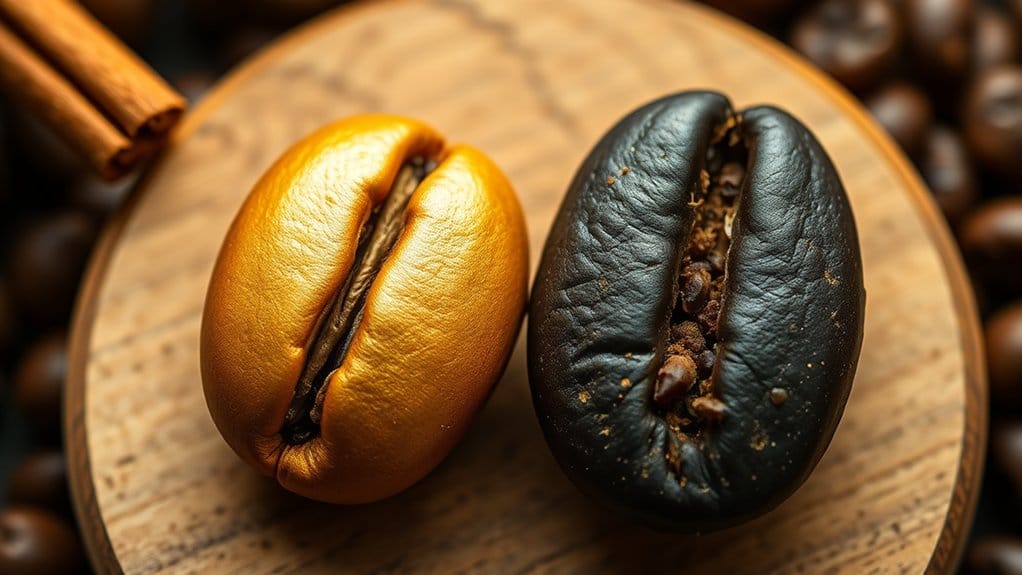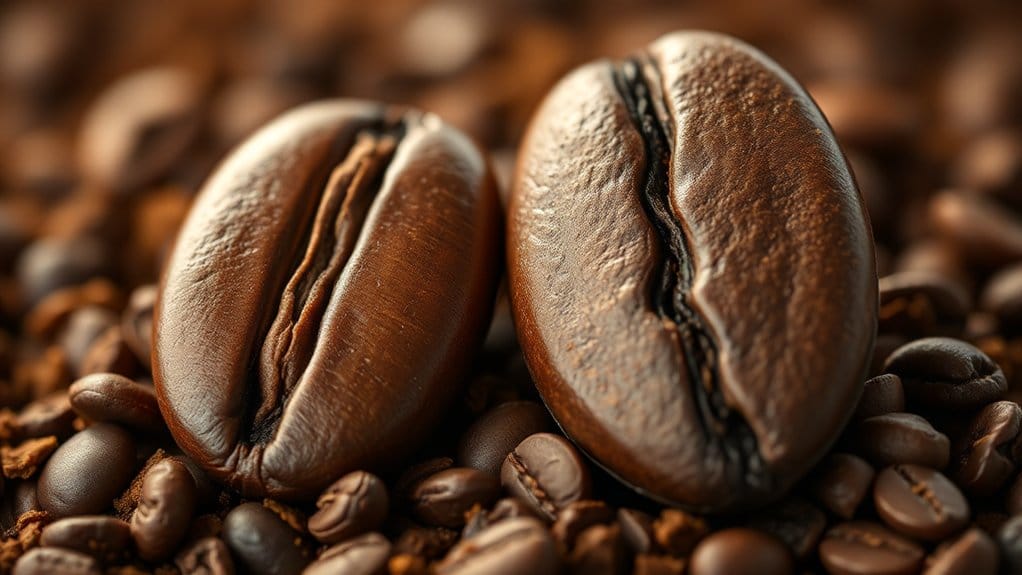Physical Address
304 North Cardinal St.
Dorchester Center, MA 02124
Physical Address
304 North Cardinal St.
Dorchester Center, MA 02124

Regarding coffee, Arabica and Robusta have their own personalities. Arabica’s got sweet, complex flavors like berry and floral notes, almost like a charming melody. Meanwhile, Robusta struts in with its bold, bitter punch, perfect when you need a jolt. It’s smoother with more lipids and sugars, making for a creamy sip. If you want to know how they differ in caffeine and price, stick around; there’s more brewing!

When you take a sip of coffee, the flavors dancing on your palate can tell you a lot.
Arabica coffee is like a melodious arrangement, featuring complex notes of fruit and floral touches. Imagine tasting berry, jasmine, or even a hint of chocolate as you sip! Each cup reflects where it’s grown, with Ethiopian beans murmuring floral secrets as Brazilian ones sing fruity joys. The growing conditions in which Arabica flourishes, particularly at higher altitudes, play a crucial role in enhancing its flavor complexity. Additionally, the various Arabica types offer distinct flavors, adding to the delightful experience.
Conversely, Robusta packs a punch. It’s bolder, earthier, and often comes off as bitter. Think of it as the grumpy uncle at a family gathering—he gets the job done but isn’t winning any taste contests.
While both have their place, Arabica is often the star, especially for those who appreciate a sweeter hug in their coffee.
Coffee isn’t just an orchestra of flavors; it’s also a balance of energy. When you choose between Arabica and Robusta, caffeine content plays a big role.
Robusta beans pack about 2.2% to 2.7% caffeine, compared to Arabica’s 1.2% to 1.5%. This means a 12-ounce cup of Robusta gives you roughly 190 mg of caffeine, nearly double the 98 mg in Arabica. Robusta has roughly twice as much caffeine compared to Arabica, making it a popular choice for those who want a stronger coffee experience. Additionally, Robusta is known for its higher caffeine content which contributes to its bold flavor profile. When considering options for a high caffeine boost, Robusta beans lead in caffeine content and are often favored in espresso blends.
So, if you need a morning kick, Robusta’s your buddy. On the other hand, if you fancy a smoother sip, Arabica’s lower caffeine offers a gentler buzz.
Picture your espresso: if it’s made with Robusta, get ready for a strong jolt! It’s all about finding the right balance for your coffee adventure.
What’ll it be today?

Ever wondered how the lipids and sugars in your coffee influence its flavor?
Well, if you sip Arabica, you’re enjoying about 16% lipids, giving it a smooth, rich mouthfeel. Strong, in contrast, has just 10.1%. Those tasty lipids not only make your drink creamy but additionally trap delightful aromas.
Now, about sugars—Arabica beans boast nearly double the sugar concentration of Strong! When you roast them, those sugars caramelize. Picture notes of maple and honey swirling in your cup. Arabica has a significantly higher sugar content, which enhances its overall sweetness.
Meanwhile, Strong’s lower sugar content creates a bolder, more bitter taste. So, if you’re after a sweeter and smoother cup, Arabica’s got you covered! How’s that for a flavor adventure?
Steering through the world of coffee prices can feel like searching for the perfect brew in a crowded café.
Arabica coffee usually fetches a higher price, around $4.8 per kilogram by 2026, whereas Robusta lags behind at about $3.9. It’s like choosing between a fancy dessert and a quick snack!
Prices for Arabica jumped 15.2% recently, whereas Robusta only rose by 6.2%. This difference hints at growing demand for that flavorful Arabica, whereas Robusta’s supply from Vietnam keeps it more stable.
And guess what? Seasonal changes can make Arabica prices swing dramatically!

In relation to crafting the perfect coffee blend, most baristas and home brewers seem to favor the delightful performance between Arabica and Robusta beans. Arabica brings smooth, fruity flavors, whereas Robusta adds a punch with its bold earthiness.
If you’re after a fruity blend, go for an Arabica-heavy mix; it’ll sway on your palate! But if you need a caffeine kick, Robusta’s your buddy. Balanced blends, around 50-60%, can be magical, mixing creamy, rich textures, and complex aromas like chocolate and honey.
Experimenting with different roast levels can further enhance your blend, allowing for unique flavor profiles that cater to every coffee lover’s taste. Try making a latte with these! You’re catering to all preferences: light and nuanced or strong and sturdy. It’s like choosing between a gentle hug and a bear hug—both are delightful in their own way!
Regarding growing coffee beans, understanding the differences in cultivation practices between Arabica and Robusta can feel like venturing into an exciting cosmic coffee quest!
Arabica prefers higher altitudes, usually between 2,000 to 6,000 feet, whereas Robusta thrives in warm, low-lying areas. You might love Arabica for its rich flavor, but it requires a lot of TLC to fend off pests and diseases.
Conversely, Robusta is like that resilient friend who can handle anything, needing much less fuss. With higher yields and uniform ripening, Robusta makes harvesting a breeze, whereas Arabica’s irregular cherries mean more hand-picking.
It’s clear; each type has its own charm and challenges throughout the expedition to your cup!

When you think about brewing coffee, you might feel like a mad scientist in a lab, trying to reveal the perfect potion. Choosing between Arabica and Robusta? It’s all about technique!
For espresso, a blend of 10-30% Robusta boosts crema and strength, whereas Arabica adds sweetness. If you’re pouring-over or using a drip method, high Arabica content brings out those bright, nuanced flavors.
Want a smooth French press? Mix both varieties for balance. Remember, water temperature should hover between 195°F and 205°F for ideal results. Additionally, adjusting your grind size is crucial, as it affects extraction and flavor complexity in your final brew.
Experiment with grind size and brew time—too long with Robusta can bring out bitterness. So, roll up your sleeves, and have fun unlocking those flavors! Your perfect cup awaits.
When considering health benefits, you’ll find Arabica offers balanced antioxidants and lower caffeine, making it suitable for daily consumption. Vigorous, with its higher caffeine, might boost metabolism and athletic performance but can cause discomfort for some.
Roasting substantially influences coffee flavors. When you roast Arabica lightly, you’ll preserve its fruity and floral notes. Conversely, roasting Robusta darker helps soften its bitterness, enhancing chocolatey and nutty flavors instead.
Yes, you can use Arabica in espresso machines. Many brands offer compatible Arabica coffee capsules designed for ideal extraction, providing a smooth, flavorful shot that’s perfect for your espresso experience. Enjoy the rich taste!
If you’re looking to grow Arabica, consider regions like Colombia and Ethiopia for their ideal climates. For Robusta, Vietnam and Indonesia offer suitable conditions, tolerating higher temperatures and lower altitudes during thriving in various soil types.
Storage markedly impacts coffee flavors. If you expose beans to air, humidity, and high temperatures, expect degradation. Keep them airtight, cool, and dry to preserve those delightful notes you’ve come to enjoy so much.